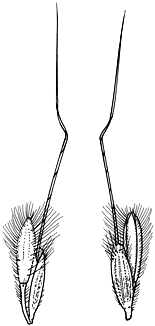Dichanthium setosum S.T.Blake APNI* 
Description: Erect perennial to < 1 m high.
Leaves with sheath glabrous except at the nodes; ligule to 1 mm long; blade 2–3.5 mm wide, with tubercle-based hairs or glabrescent.
Racemes 1–3, to 8 cm long. Lowest pairs of spikelets male; joints and pedicels c. 2 mm long, ciliate with hairs increasing upwards to 2 mm long. Sessile spikelets 5–6 mm long; callus obtuse, often densely bearded with hairs to 1 mm long. Lower glume pilose with a subhyaline area at the apex, long ciliate on the keels and on a transverse subapical arch with tubercle-based hairs to 3.5 mm long. Lower lemma 2.5 mm long; upper lemma stipe-like, 1-nerved, with an awn c. 25 mm long. Pedicellate spikelets male, 5–6 mm long. Lower glume with long tubercle-based hairs; upper glume subequal, 3-nerved. Lower lemma c. 4 mm long; upper lemma to 2.7 mm long. Anthers 2–2.2 mm long. Grain 3 mm long.
Flowering: summer.
Distribution and occurrence: Grows in woodland.
NSW subdivisions: NT, CT, NWS, CWS, NWP
Other Australian states: Qld W.A.
Threatened species: NSW BCA: Vulnerable; Commonwealth EPBC: Vulnerable
This species is considered data-deficient by Saving our Species (SoS, DPIE) which means a conservation project cannot be developed for it. Visit their website and contact SoS if you have additional information.
Text by S. W. L. Jacobs & C. A. Wall
Taxon concept: Flora of NSW 4 (1993)
APNI* Provides a link to the Australian Plant Name Index (hosted by the Australian National Botanic Gardens) for comprehensive bibliographic data
***The AVH map option provides a detailed interactive Australia wide distribution map drawn from collections held by all major Australian herbaria participating in the Australian Virtual Herbarium project.
|


